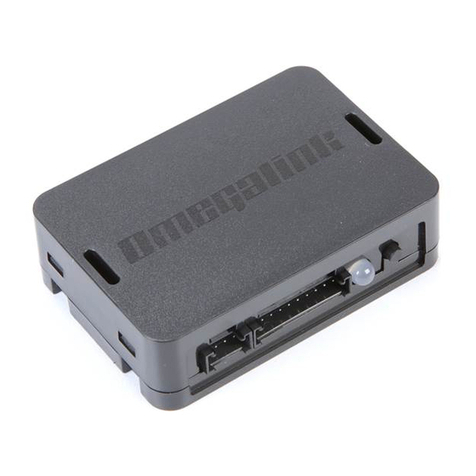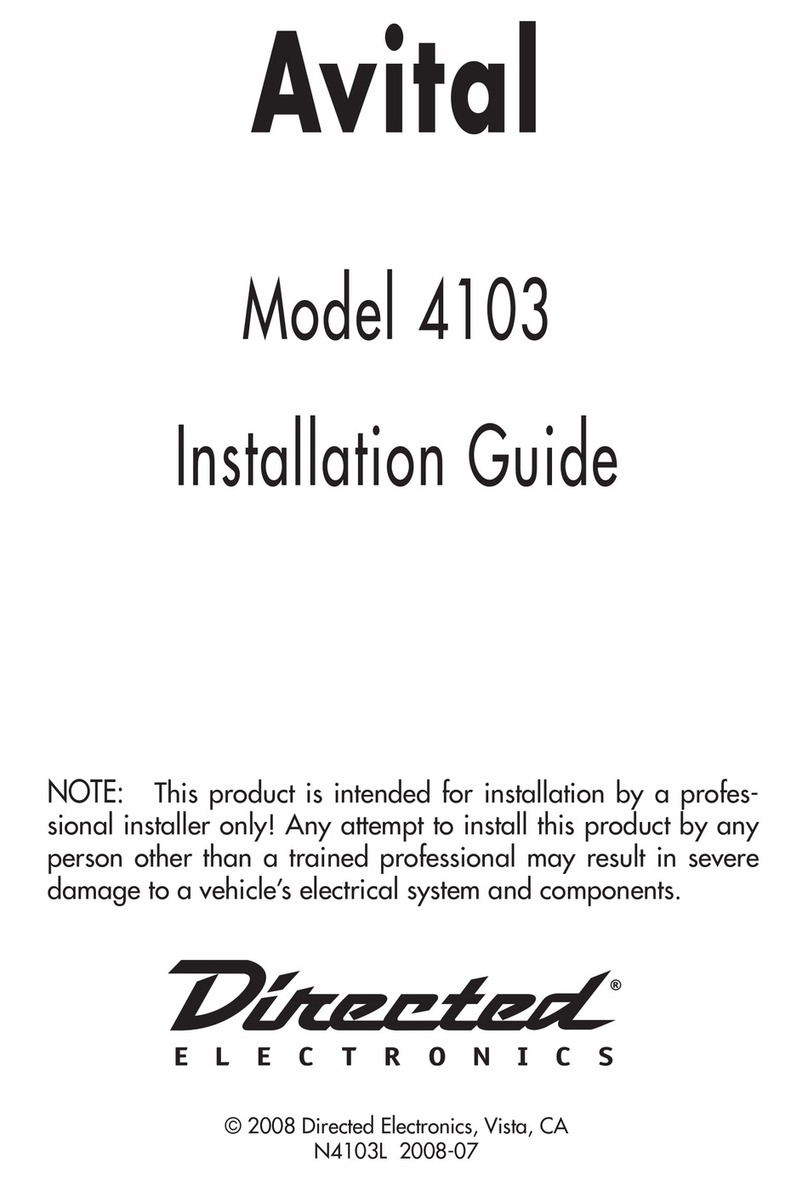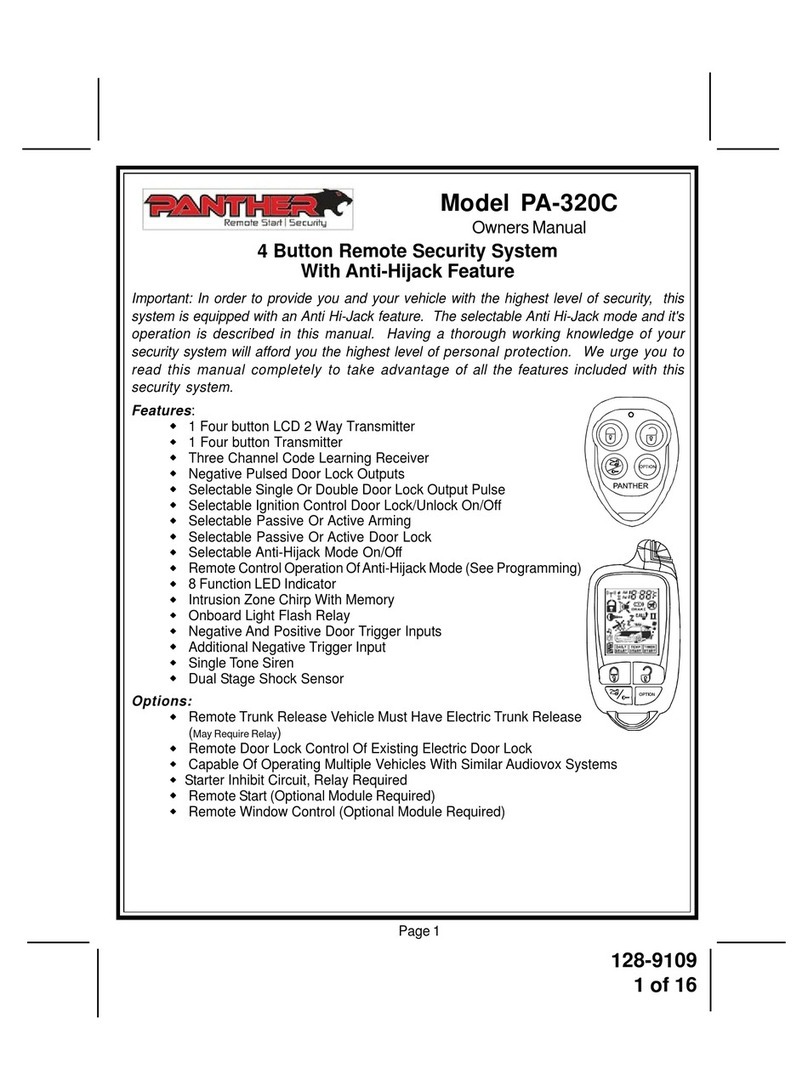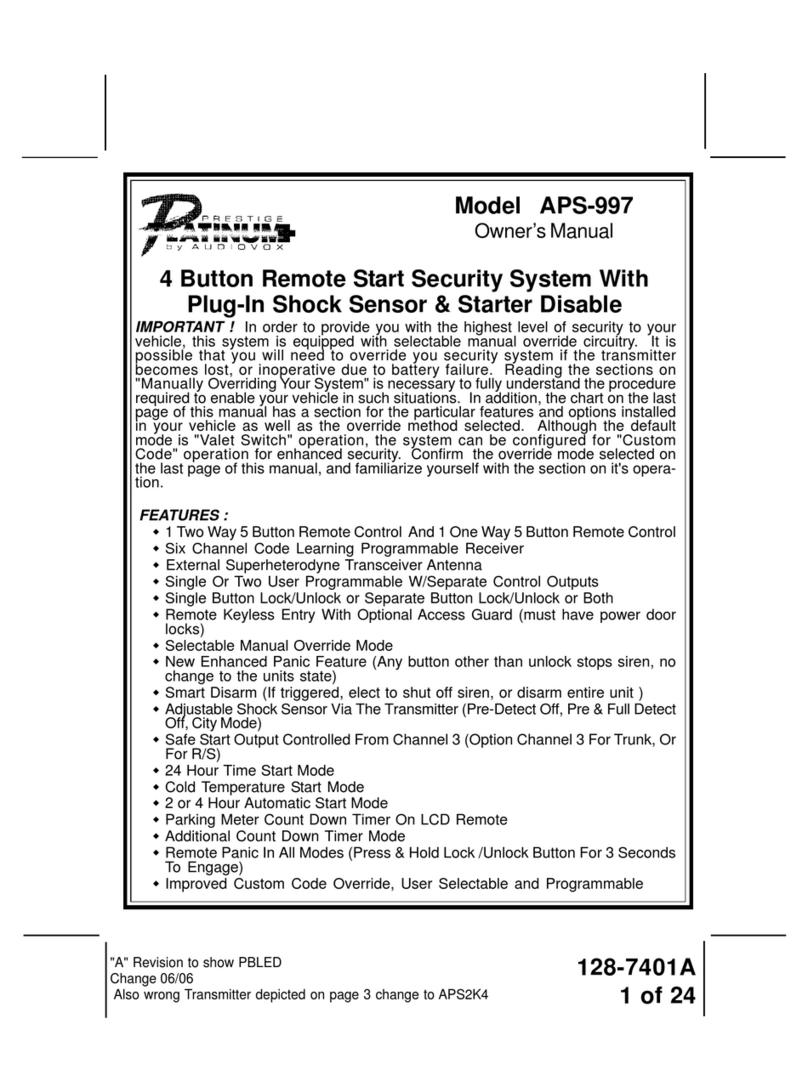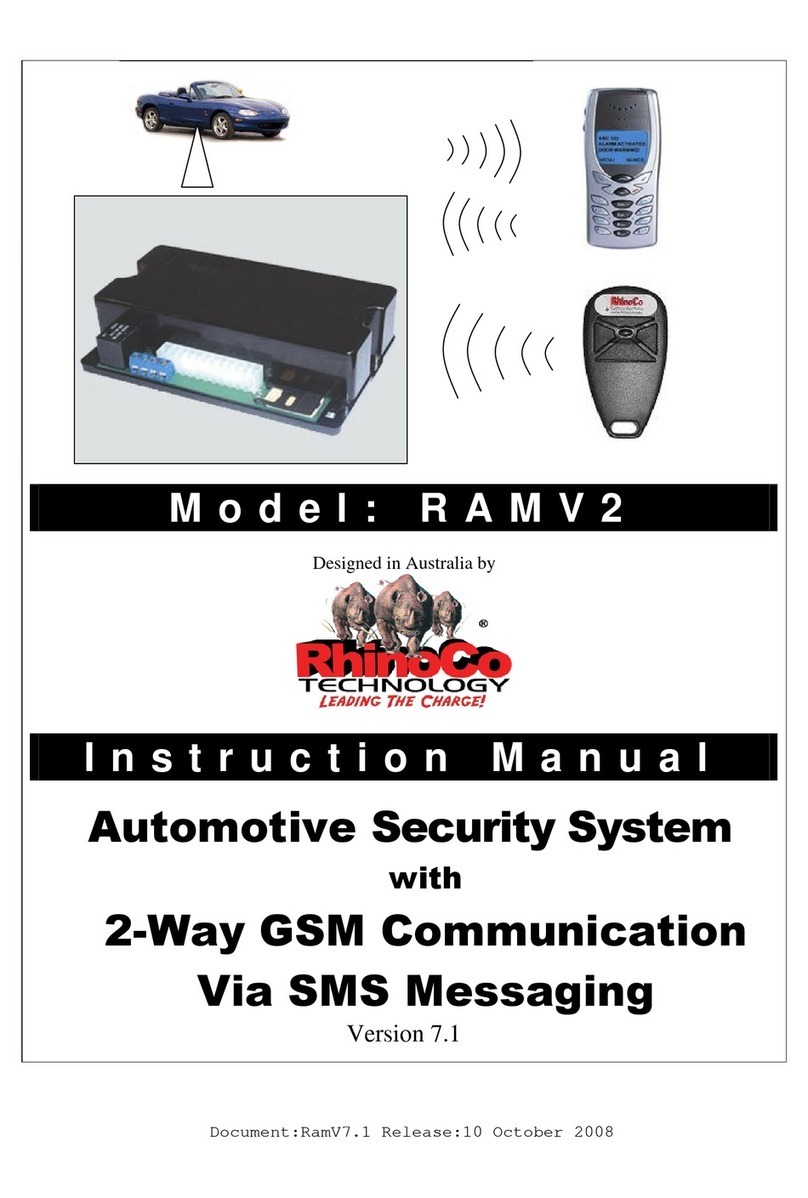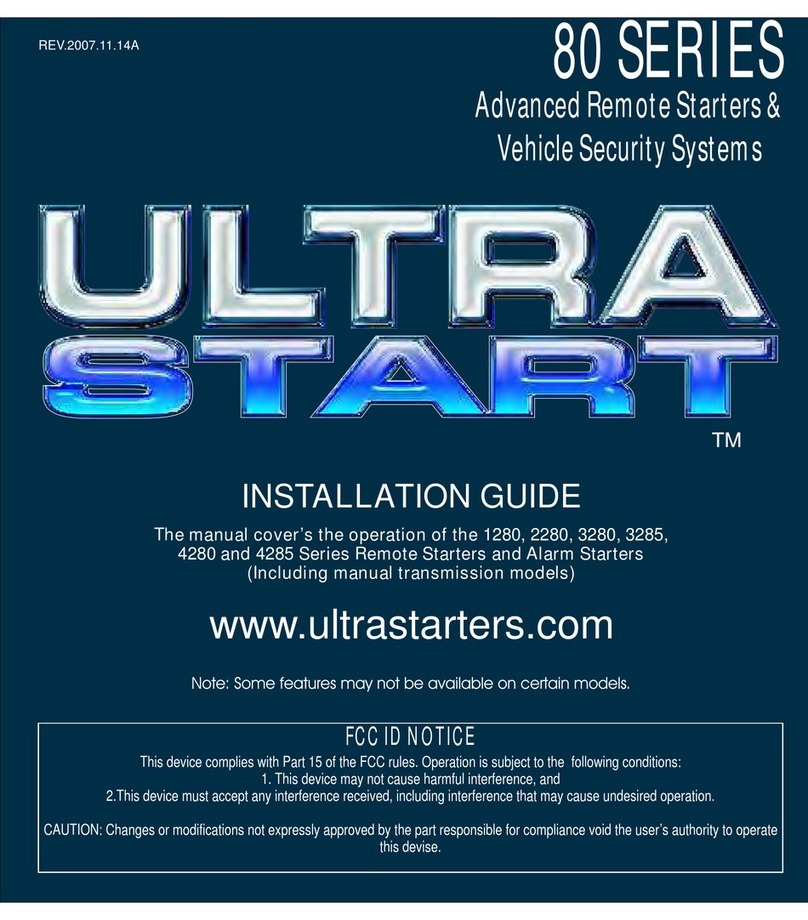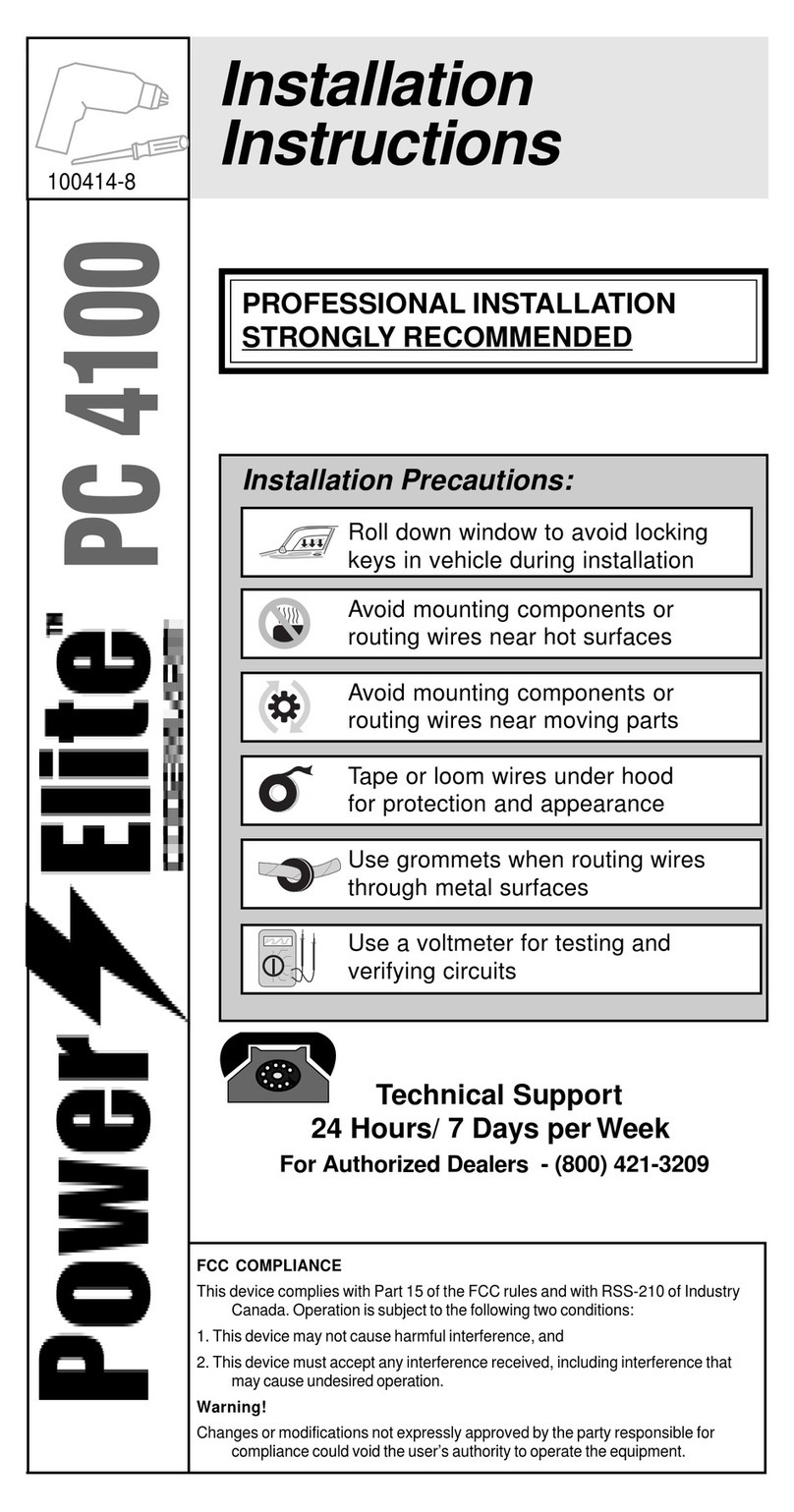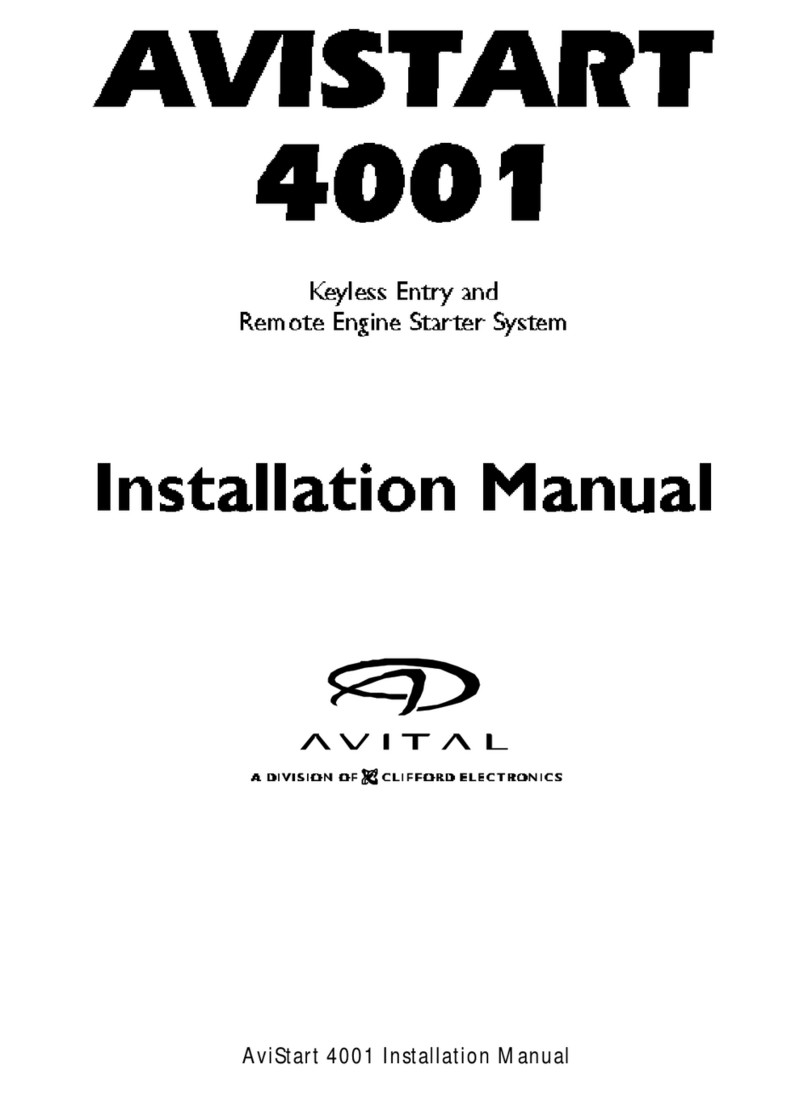Firstech CM-2300 User manual

Manual De Instalación
de Firstech LLC, Version: 1.0
Aplicable a los siguientes sistema de alarma:
CM-2300 – Modulo de Control de
Alarma/Apertura
Este dispositivo cumple con la Parte 15 de las normas de la FCC. funcionamiento está sujeto a las siguientes
condiciones;
(1) Este dispositivo no puede causar interferencias perjudiciales.
(2) Este dispositivo puede aceptar cualquier interferencia recibida, incluidas las que puedan provocar un
funcionamiento no deseado.
PRECAUCIÓN: Los cambios o modificaciones que no hayan sido expresamente aprobados por la parte
res
p
onsable del cum
p
limiento
p
ueden anular la autoridad del usuario
p
ara utilizar este dis
p
ositivo.
techfeed.compustar.com
Installation Manual
By Firstech LLC, Version: 1.0
Applicable to the following alarm system:
CM-2300 – Alarm/Keyless Control Module
This device complies with Part 15 of the FCC rules. Operation is subject to the following conditions;
(1) This device may not cause harmful interference.
(2) This device may accept any interference received, including interference that may cause undesired operation.
CAUTION: Changes or modifications not expressly approved by the party responsible for compliance could void the
user’s authority to operate this device.
techfeed.compustar.com

Table of Contents
Introduction...............................................................................................................................................3
Kit(s) Contents ..........................................................................................................................................3
Installation Basics ....................................................................................................................................4
Remote Code Routine(s)..........................................................................................................................5
Placement and Use of Components........................................................................................................5
Common Procedures................................................................................................................................6
Valet Mode..............................................................................................................................................6
Jumper Settings ......................................................................................................................................6
Jumper 1 (Door Trigger Polarity) .........................................................................................................6
Jumper 2 (Parking Light Polarity Output).............................................................................................6
CM-2300 Firmware .................................................................................................................................6
CM-2300 Wiring Schematic......................................................................................................................7
CM-2300 Wire Chart ...............................................................................................................................8
Connector 1 (CN1), 6-Pin Main Harness ................................................................................................8
Connector 2 (CN2), 6-Pin Lock Harness.................................................................................................9
Connector 3 (CN3), 8-Pin Harness .........................................................................................................9
Connector 4 (CN4), 4-Pin (Shock Sensor Port) ....................................................................................10
Connector 5 (CN5), 2-Pin (Pre-wired LED)...........................................................................................10
Connector 6 (CN6), 4-Pin (Antenna Cable) ..........................................................................................10
Connector 7 (CN7), 4-Pin (RS232 Data Port).......................................................................................11
Option Programming Tables..................................................................................................................11
Option Menu Descriptions .....................................................................................................................13
Option Programming..............................................................................................................................15
Quick Change From Remotes...............................................................................................................15
Option Programming Using the FT-OP500-KIT .................................................................................... 16
Option Programming Using Compatible Remotes ................................................................................16
Troubleshooting......................................................................................................................................17
Alarm LED Diagnostics .........................................................................................................................17
Frequently Asked Questions.................................................................................................................18
Technical Support Contacts ..................................................................................................................19
2
Introduction
Introduction
Thank you for purchasing a Firstech alarm/keyless system for your vehicle. The following installation
manual is intended for experienced and authorized mobile and alarm technicians. This is not a tutorial on
how to install. We highly recommend that you contact your local Firstech dealer and seek professional
installation.
Thank you for purchasing a Firstech alarm/keyless system for your vehicle. The following installation
manual is intended for experienced and authorized mobile and alarm technicians. This is not a tutorial on
how to install. We highly recommend that you contact your local Firstech dealer and seek professional
installation.
Call 888-820-3690 or visit our website at www.compustar.comCall 888-820-3690 or visit our website at www.compustar.com to locate your nearest dealer.
Caution: The Manufacturer’s warranty will be void if this product is installed by anyone other than an
authorized dealer. Firstech reserves installation support services for authorized dealers only.
Kit(s) Contents
The CM-2300 includes all your basic components for basic install.
- Alarm/Keyless Control Module CM-2300
- 1 x Shock Sensor
- 1 x Siren
- Pack of Wiring Harnesses
3

Installation Basicsallation Basics
If you are new to installing Firstech alarm units, we highly recommend that you thoroughly review this
manual before installing your first unit.
If you are new to installing Firstech alarm units, we highly recommend that you thoroughly review this
manual before installing your first unit.
Key Points to Consider Before InstallationKey Points to Consider Before Installation:
The two remotes are preprogrammed to the unit Page 5
This system is designed for ease of installation and the two included remotes are preprogrammed. In the
event you may need to program new remotes cycle the ignition ON / OFF five times within seven
seconds and tap the Lock button (half second) on the first remote, and then tap the Lock button (half
second) on the second remote.
RemoteValetProcedure Page 5
Previous Firstech designed systems allow you to put the vehicle in Valet Mode by tapping the Lock and
Trunk buttons at the same time. This feature requires you to turn the ignition on and then tap the Lock
and Trunk buttons to enter Valet.
OptionMenus Page 11
The CM-2300 option menu differs completely from other Firstech systems. It is important to familiarize
yourself with these as it will save time in most applications.
Option Programmer (FT-OP500-KIT) Page 15
Most options on this unit can be programmed with the remote(s) as well as the Option Programmer
(OP500). Please note the system must be disarmed before connecting the OP500. Otherwise, an
“ERROR” message will show on the display of your OP500. Connect the OP500 by unplugging the
antenna and plugging into the blue 4 pin port at the top of the programmer.
UpdatableFirmware
The firmware on the CM-2300 can be updated using our USB Updater Cable. Sign up on
techfeed.compustar.com for instructions and exclusive dealer access.
4
Remote Code Routine(s)Remote Code Routine(s)
IMPORTANT: The remotes are preprogrammed to the control module. In the event that you need to
program the remotes, follow the instructions below.
IMPORTANT: The remotes are preprogrammed to the control module. In the event that you need to
program the remotes, follow the instructions below.
Programming the RemotesProgramming the Remotes
STEP 1: Activate Programming mode by turning the ignition key on and off (between the Acc & On
positions) five times within 7 seconds. The vehicles parking lights will flash once with the successful
completion of this step.
STEP 2: Within a second after cycling the ignition the 5
th
time, tap the Lock button on the remote for a
half second. The parking lights will flash once to confirm the transmitter has been coded.
Programming Multiple Remotes: After the confirmation flash given
in STEP 2, you can code additional remotes by tapping the Lock
button on the remote(s). The parking lights will flash once confirming
each additional remote. The CM-2300 can store up to three remotes.
Exiting Programming: Programming is a timed sequence. If you can
not get the remote(s) to program then the system enters Valet Mode.
The parking lights will flash twice signaling the end of programming
mode.
Placement and Use of Components
IMPORTANT: The placement and use of components are critical to the performance of this system.
Antenna
The antenna on the CM-2300 is internal and wired directly to the control module. There is no need to run
a cable up the A pillar unless you are using a different RF Kit.
Shock Sensor
For best results, mount the shock sensor by zip tying it to the vehicles main ignition harness. There is a
small dial on the sensor that ranges from Off to 10. The higher the number on the dial the greater
sensitivity of impact. A small adjustment to the dial can make a significant difference in sensitivity for both
1
st
and 2
nd
stages. Recommended dial settings for most vehicles is somewhere between 2 & 4. The
system begins monitoring the shock sensor 30 seconds after the alarm is armed. Also the alarm LED will
stay solid after arming until the shock sensor is active.
Siren
Option 1-06 will allow you to change the volume of the siren chirps. To adjust duration time when the
alarm has been triggered, change Option 1-05 – the system default is 30 seconds.
5

Common ProceduresCommon Procedures
Valet ModeValet Mode
When servicing or loaning your vehicle to others, your alarm system should be placed in Valet mode.
Valet mode disables all alarm functions as well as parking lights.
IMPORTANT: While in Valet mode your remotes will still lock and unlock the doors.
The system can be put into valet one of two ways:
1. Turn the vehicles key to the ignition “on” position and hold the Lock and Trunk buttons
simultaneously for a half second. The parking lights will flash once to confirm the system is in
valet mode. Repeat this process to take the system out of valet mode. Your ignition does not
have to be "on." Upon tapping the same buttons again the parking lights will flash twice to confirm
the system is out of valet mode.
2. You can put the system into valet by turning the ignition key “on” and then “off” five
times within 7 seconds. The parking lights will flash once to confirm the system is in
valet mode. Shortly after the first flash, the parking lights will flash twice.
Jumper Settings
Caution: Jumper settings affect the polarity and use of certain outputs. If these jumpers are used
incorrectly, damage to the vehicle and control module may occur.
Jumper 1 (Door Trigger Polarity)
Determines the polarity of the door trigger input wire (red/white). In the default position the door trigger
registers negative (-) triggers. To change to a positive (+) trigger, move the jumper.
Jumper 2 (Parking Light Polarity Output)
Determines the output polarity of the green/white wire on connector one (CN1). In the default position it
provides a positive (+) parking light output. To change to a negative (-) parking light output move the
jumper.
CM-2300 Firmware
The CM-2300 control module is firmware updatable through the internet. In the event Firstech makes any
changes or corrections you can update the module using the grey RS232 Data Port on the control
module. This requires the USB updater cable.
6
CM-2300 Wiring Schematic
7

CM-2300 Wire Chart
We’ve added wire color tags to our CM-2300. Please see the table below for wire details.
Function Tag Color Polarity Connector
Location Pin Number Wire Color
Ignition Input Yellow + CN1 2 Green
Door Trigger Input Green + or - CN1 4 Red/White
Parking Light Output White + or - CN1 5 Green/White
Trunk Output Red/White - CN2 2 Violet/White
Lock Output Green - CN2 5 Blue/Black
Horn Honk Output Brown/Black - CN3 1 White
Arm Output Orange - CN3 2 Blue
Instant Trigger Input Blue - CN3 3 Gray/Black
Dome Light Supervision
Output Black/White - CN3 4 Violet
Connector 1 (CN1), 6-Pin Main Harness
Pin 1 Red - Constant 12V positive (+) power input. This wire must be connected. The proper vehicle
wire will test (+) 12V at all times - while the key is in the off position, the on position and during
crank.
Pin 2 Green (Wire Tag: Yellow) – Ignition 12V positive (+) output and input. This wire must be
connected to the vehicle’s ignition for remote start and valet / remote programming. The proper
wire will test 0V with the key in the off position, 12 V (+) while the key is in the on position and
12V (+) during crank.
Pin 3 Brown - Siren 12V positive (+) output. Connect this wire to the red (+) wire located on the siren.
To change siren output settings, review Option 1-05.
Pin 4 Red/White (Wire Tag: Green) - Door trigger input. This wire requires negative (-) or positive (+)
trigger door-pins. The proper wire provides a (-) or a (+) trigger only when the doors are opened.
You will need to test the wire for proper polarity and set the jumper on the side of the CM-2300 for
the corresponding polarity.
.
Pin 5 Green/White (Wire Tag: White) – This is the positive (+) and negative (-) parking light wire that
triggers when you lock and unlock the doors and alarm goes off. The polarity of this output is
selectable via a jumper on the side of the CM-2300.
8
Pin 6 Black - Ground negative (-) input. This wire must be connected to the vehicle’s ground.
Connector 2 (CN2), 6-Pin Lock Harness
Pin 1 Not used
Pin 2 Violet/White (Wire Tag: Red/White) - Trunk release 250mA negative (-) output. This is an
optional output that will release the trunk. System will unlock doors and disarm alarm prior to
trunk release.
Pin 3 Orange/Black – 2
nd
Pulse Unlock wire. This wire is used to provide the customer with a driver’s
priority unlock feature with option 1-04. With the option on the unlock (blue) wire will pulse first
and then orange/black will pulse if the unlock button is pressed again within 3 seconds.
Pin 4 Blue - Unlock 250mA negative (-) output. This is an optional output that will provide a (-) pulse for
unlocking doors. System will unlock doors and disarm alarm. IMPORTANT: You must use
relays to reverse polarity for (+) trigger door lock systems.
Pin 5 Blue/Black (Wire Tag: Green) - Lock 250mA (-) negative output. This is an optional output that
will provide a (-) pulse for locking doors. System will lock doors and arm alarm. IMPORTANT:
You must use relays to reverse polarity for (+) trigger door lock systems.
Pin 6 Not used
Connector 3 (CN3), 8-Pin Harness
Pin 1 White (Wire Tag: Brown/Black) - Horn honk 250mA negative (-) output. This is an optional
output that will pulse the factory horn. The proper wire will show ground (-) while the horn is
sounding.
Pin 2 Blue (Wire Tag: Orange) – Ground when armed output. This wire sends a (-) negative output
when the alarm is armed. It triggers the starter kill relay for the CM-2300. It can also be used for
other options like window roll-up.
Pin 3 Gray/Black (Wire Tag: Blue) – Instant negative (-) trigger input. This input looks for a ground (-)
input when the system is armed/locked. Once it detects a (-) negative signal it will trigger the full
alarm.
Pin 4 Violet (Wire Tag: Black/White) - Dome light 250mA negative (-) output. This is an optional
output that provides a 45 second (-) negative output after system is unlocked for dome-light
supervision. This can also be used to trigger factory rearm. To change dome light output settings,
review Option 2-04.
Pin 5 Gray/White - Auxiliary Input 1 – This wire functions as a negative (-) pre-warn input. It is
selectable based on option 2-12. It can be changed to a negative arm, negative ignition, negative
instant trigger, negative shock sensor bypass, or negative closed loop trigger input. Please refer
to the option tables for details.
9

Pin 6 Black/White - Auxiliary Input 2 – This wire functions as a negative (-) instant trigger input. It is
selectable based on option 2-13. It can be changed to a negative disarm or negative drive lock
control. Please refer to the option tables for details. This wire is required for ignition controlled
door locks.
Pin 7 Yellow - Auxiliary 1 Output – This wire provides a customized timed output for triggering extra
sensors and/or features such as power sliding doors or power windows. The settings can be
changed via option 2-08. To set a custom timed output you must use option setting 4 as well as
an OP500 Option Programmer.
Pin 8 Yellow/White - Auxiliary 2 Output – This wire provides a customized timed output for triggering
extra sensors and/or features such as power sliding doors or power windows. The settings can be
changed via option 2-09. To set a custom timed output you must use option setting 4 as well as
an OP500 Option Programmer.
Connector 4 (CN4), 4-Pin (Shock Sensor Port)
Pin 1 Black - Negative (-) ground.
Pin 2 White - 2
nd
stage negative (-) input. (Instant trigger)
Pin 3 Red - 12V positive (+) output.
Pin 4 Yellow - 1
st
stage negative (-) input. (Warn away)
Connector 5 (CN5), 2-Pin (Pre-wired LED)
Note: Do not mistake for Thermister port.
Pin 1 Black - L.E.D negative (-) ground.
Pin 2 Black/White- L.E.D. 3V positive (+) output.
Connector 6 (CN6), 4-Pin (Antenna Cable)
Pin 1 Yellow - RX input. This wire receives the signal from remote.
Pin 2 White - TX output. This wire transmits the signal to remote.
Pin 3 Red – Constant 12V positive (+) output.
Pin 4 Black – Negative (-) ground.
10
Connector 7 (CN7), 4-Pin (RS232 Data Port)
Pin 1 Constant 12V positive (+) output
Pin 2 Negative (-) ground
Pin 3 RX
Pin 4 TX
Option Programming Tables
IMPORTANT: System must be unlocked before you can set options with the OP500 or remotes.
Feature Default
Setting- I Optional
Setting - II Optional
Setting - III Optional
Setting - IV
1-01 Lock/Unlock Pulse
Duration 0.8 sec 2.5 sec 0.125 sec 3.5 sec
1-02 Double Pulse Locks Off Unlock Lock Both
1-03 Driver’s Priority Unlock Off On
1-04 Ignition Locks*
Ignition and 30
Sec After
Doors Closed
Drive Lock
Control and
Wire
Off
1-05 Siren Duration 30 Seconds 60 Seconds 120 Seconds Chirp for 20
Seconds
1-06 Confirmation Chirps
Length
Medium
(30ms) Short (15ms) Normal
(60ms)
1-07 Auto Rearm Off 30 Seconds 60 Seconds 5 Minutes
1-08 Passive Arming* Off On Passive
Without Locks
1-09 Dome Light Delay Off 5 Seconds 45 Seconds Auto
1-10 Valet Mode
Key 5 times,
or Remote
(I+III) while
ignition is on
Key 5 times or
Remote (I+III)
1-11 Open Door Notification On Off
1-12 Factory Alarm Option On Off
1-13 Siren/Horn Mute Control
With Remote Disabled Enabled
11

Feature Default
Setting- I Optional
Setting - II Optional
Setting - III Optional
Setting - IV
2-01 Horn Output On Double
Lock
On Lock and
Unlock Alarm Only
2-02 Horn Honk Pulsed Latched
2-03 (-) Ground When Armed Latched when
armed 0.5 sec 20 Seconds Program →
Aux 4
2-04 Dome Light Output
Factory
Rearm + 45
sec
Factory
Rearm 45 Seconds Off
2-05 Unlock/Disarm with Trunk
Release
Unlock,
Factory
Disarm, and
Trunk Release
Factory
Disarm, Trunk
Release Only
Trunk Release
Only Aux 3
2-06 Trunk Output Timing 1 sec 0.5 sec 2 sec Program →
Aux 3
2-07 Secure Aux Output On While
Armed On Off
2-08 Aux 1 Output 0.5 sec Latched 20 Seconds Program
2-09 Aux 2 Output 0.5 sec Latched 60 Seconds Program
2-10 Aux 1 Output Control By Remote Arm Disarm Ignition Off
2-11 Aux 2 Output Control By Remote Arm Disarm Panic
2-12 Auxiliary Input 1 (-) Pre-Warn (-) Arm (-) Closed
Loop
(-) Ignition,
Instant Trigger
& Shock
Sensor
Bypass
2-13 Auxiliary Input 2** (-) Trigger (-) Disarm (-) Key Sense (-) Drive Lock
Control**
2-14 Shock Sensor Input
1st Input -
Prewarn | 2nd
Input - Trigger
1st Input -
Disable
Arm/Disarm |
2nd Input -
Trigger
1st Input -
Prewarn | 2nd
Input - Disable
Arm/Disarm
2-15
Aux 1 and Aux 2 Control
for iDatalink Modules*
(Sliding Doors)
Off
Unlock,
Factory
Disarm, and
Sliding Door
Control
Factory
Disarm and
Sliding Door
Control Only
Special Option Group
Feature Setting Value
1 AUX 1 Output Time 1 - 100 seconds
2 AUX 2 Output Time 1 - 100 seconds
3 AUX 3 Output Time 1 - 100 seconds
4 AUX 4 Output Time 1 - 100 seconds
12
*Once programmed, this feature requires activation from the remote. Please refer to the
remote user manual or the option description below.
**This input is required for ignition controlled door locks.
Option Menu Descriptions
1-01 Lock / Unlock Pulse Duration – This option changes the length of the lock and unlock ground
pulses on the blue and blue/black wires on CN3. The default setting is for 0.8 seconds. Optional
setting 2 changes the duration to a 2.5 second pulse. The third setting changes the duration to a
short 0.125 second pulse setting. The fourth setting changes the duration to a 3.5 second pulse.
1-02 Double Pulse Locks – This option pulses the unlock (blue) wire twice. This will unlock all doors
and/or disarm the factory alarm on some vehicles. This option can be changed to optional
setting 2 by the remote. Please see page 16 for details.
1-03 Driver’s Priority Unlock – This lets you use the CM-2300 to unlock the driver’s door before the
rest of the doors as in some factory systems. The user has the hit the unlock button on the
remote a second time to unlock the rest of the doors. The driver’s door must be isolated from the
other doors. Use the Orange/Black CN3 as your 2
nd
Unlock output.
1-04 Ignition Controlled Locks – When you turn this option on and have the power door locks
connected the doors will lock in 30 seconds when you start the vehicle with the key. Option
setting 2 requires the (-) Drive Lock Ctrl (Aux 2 input - please see option 2-13-IV) wire connection.
When you turn the key off the doors will unlock if this feature is turned on. This feature also
requires activation from the remote. Simultaneously tap the Lock + Remote Start buttons for a
half second to activate ignition controlled door locks from the remote. The parking lights will flash
once to indicate this feature is ON.
1-05 Siren Duration – The default setting for the siren output upon panic or alarm trigger is 30
seconds. You have the ability to extend that with this option. Please see the option tables for
other available settings.
1-06 Confirmation Chirps – This feature controls the output of the siren wire to increase or decrease
the volume of the siren upon lock and unlock.
1-07 Auto Rearm – The system will automatically rearm and relock if there is no activity on the (green)
ignition wire or (red/white) door trigger wires. See the option table for available settings.
1-08 Passive Arming – This option must be set to 2 before you can turn Passive Arming on with the
remote. Passive Arming will happen only after the door is opened and closed. Simultaneously tap
the Unlock + Trunk buttons on the remote for a half second to activate passive arming from the
remote. The parking lights will flash once to indicate this feature is ON.
1-09 Dome Light Delay – This option is used when connecting the door trigger input to the vehicles
dome light circuit. It delays the door trigger input to prevent the door open notification. Please
see the option table for available settings.
1-10 Valet Mode – This option changes how to enter Valet Mode with the remote.
Default 1: Key on/off five times or remote valet (Lock + Trunk for 0.5 seconds) with key in the on position.
13

Option 2: Key on/off five times or remote valet (Lock + Trunk for 0.5 seconds) – key does not need to be in the on
position.
1-11 Open Door Notification – With this option the CM-2300 will notify the user if they try to arm their
vehicle while a door or trunk is open. The user will receive 3 or 4 chirps and parking light flashes
when they try to arm/lock their vehicle. You may turn this feature off with setting 2.
1-12 Factory Alarm Option - This feature controls the alarm features in the CM-2300 and is set by
default to on. If you want to use the CM-2300 for keyless only, change the option setting to off.
1-13 Siren/Horn Mute Control on Remote – This Feature controls whether the remote can mute the
Siren or Horn from the remote and is set by default to disabled. This will not allow you to mute the
audible output from the CM-2300 by remote. If you want to control the mute feature from the
remote enable this feature.
2-01 Horn Output – This option sets the behavior of the horn wire during alarm state, during double
lock from the remote or during lock and unlock from the remote. During one of the options the
event will send a negative pulse on the white wire on CN3.
2-02 Horn Honk – This option sets the duration of the output on the horn (white) wire. At default it will
pulse depending on option 2-01. At the optional setting it will latch a ground trigger to use for
triggering another siren.
2-03 Ground When Armed – Ground When Armed or GWA, at default setting, will send a constant
latched negative output when armed on the blue wire on CN3. This is used to trigger your starter
kill relay. The optional settings change how long the GWA will send a trigger. Optional setting 4
will make the blue wire an Auxiliary 4 which is programmable by your OP500 Option Programmer.
2-04 Dome Light Output - This option sets the timing output of the Dome Light (violet) wire on CN3.
Default 1: This is a combination of 2 and 3.
Option 2: Factory Rearm – This system will pulse the dome light output during lock/arm.
Option 3: 45 second Dome Light Output – activates the dome light for 45 seconds upon unlock/disarm.
Option 4: Off
2-05 Unlock/Disarm With Trunk Release – This option has 4 settings. The settings are self
explanatory but option 4 turns the trunk release wire (violet/white) on CN2 into an Auxiliary 3
which is also programmable via the OP500.
2-06 Trunk Output Timing – This option sets the output duration of the violet/white wire on CN2. The
available options are 1, 0.5, and 2 seconds. You must set the fourth option if you have option 2-
05 on setting 4.
2-07 Secure Aux Output – On the default setting, trunk and star buttons must be held for 2.5 seconds
before Aux 1 or Aux 2 can be triggered while the CM-2300 is Armed and Locked. If the CM-2300
is unlocked then just press and release the Aux buttons for normal function. If you want this
feature on all the time, change to optional setting 2. This prevents accidental triggering of the
outputs if the CM-2300 is Locked or Unlocked. You can turn Secure Aux off by changing to
optional setting 3.
2-08 Aux 1 Output - This option determines the duration of the Aux 1 output. Setting 4 allows the
output duration to be set for a specific length of time.
2-09 Aux 2 Output - This option determines the duration of the Aux 2 output. Setting 4 allows the
output duration to be set for a specific length of time.
14
2-10 Aux 1 Output Control – This option sets the condition which controls Auxiliary 1 and how it is
triggered. Please see the option table for details.
2-11 Aux 2 Output Control - This option sets the condition which controls Auxiliary 2 and how it is
triggered. Please see the option table for details.
2-12 Auxiliary Input 1 – This option changes the input condition on the gray/white wire on CN3.
Default 1: Will pre-warn with a negative (-) ground input.
Option 2: Will arm the system with a negative (-) ground input. Used when adding an alarm to a factory keyless entry
system.
Option 3: Turns the wire into a closed loop trigger. Can be used to detect if the circuit is broken like for a trailer
connected to the truck hitch.
Option 4: Turns the wire into a (-) ignition input that bypasses the instant trigger wire and shock sensor.
2-13 Auxiliary Input 2 – This option changes the input condition on the black/white wire on CN3.
Default 1:. Will instant trigger with a negative (-) ground input.
Option 2: Will disarm the alarm with a negative (-) ground input. Used when adding an alarm to a factory keyless entry
system.
Option 3: Turns the wire into a (-) Key Sense wire. If the wire sees a negative trigger it will not allow the system to arm.
Option 4: Turns the wire into a (-) Drive Lock Ctrl input. If this wire sees a negative trigger and drive lock is turned on,
the CM-2300 locks the doors and when ignition is turned off it will unlocks the doors. This setting and Auxiliary 2 input
are required for ignition controlled door locks. Connecting this wire to a (-) output from a relay triggered by the vehicle’s
foot brake is recommended for ignition controlled door lock activation.
2-14
Shock Sensor Inputs
–
This feature gives you control of the inputs of the shock sensor port. We
give you different configurations to use the CM-2300 with OEM Remote integration.
2-15 Aux 1 and Control for Idatalink Modules – This feature will control the CM-2300 disarm output
to the Idatalink modules through data when using Auxiliaries for sliding doors.
Option Programming
How to Program Options
There are three ways to set options on the CM-2300 control module. You can use the Quick Change
Sequence, the FT-OP500-KIT, or most Firstech remotes. The remotes include 4 or 5 button 1 and 2 Way
remotes.
Quick Change From Remotes
There are two options on the CM-2300 that can change without option programming. These two options
are for common settings used in the installation bay. Double Pulse Unlock and the Siren/Horn Mute
options can be changed using the feature sequence below.
Option 1-02: Double Pulse Unlock
Used to set Double Pulse Unlock (ONLY)
1) Open the Vehicle Door
2) Turn on Ignition ( within 5 seconds )
3) Press and Release the Trunk Button
4) Press and Release the Star Button
5) Press and Release the Trunk Button
6) You will see 2 Parking light flashes to indicate feature change 1- 02 to Unlock.
15

Option 1-13: Siren/Horn Mute Control From Remote
Used to enable the remote mute function
1) Open the Vehicle Door
2) Turn on Ignition ( within 5 seconds )
3) Press and Release Lock Button
4) Press and Release Unlock Button
5) Press and Release the Lock Button
6) You will see 2 Parking light flashes indicating Option 1-13 has been enabled.
Option Programming Using the FT-OP500-KIT
The OP500 can be used to change anything in the Option Tables. It is required to change settings in the
Special Option Group.
STEP 1: Make sure system is unlocked/disarmed. Connect the antenna cable to the 4 or 6 pin port on
the top of the OP500. Once connected, the OP500 will power up as long as CN1 on the control module is
connected properly.
STEP 2: Use the left or right arrow keys on the OP500 to select option. Use the up or down arrow
buttons to select the option setting. “1” is the default setting, “2”, “3”, and “4” are the optional settings.
Special Option Group 1: Change the timed output of Auxiliary 1 and 2.
STEP 3: Hold the “W” (Write) button for 3 seconds. This finalize option changes to the control module.
Wait until OP500 displays “Success” before disconnecting.
To reset the options, hold the “R” (Reset) button and “W” (Write) buttons for 3 seconds. Then hold the
“W” button for 3 seconds.
Option Programming Using Compatible Remotes
Using a remote is a timed process so review this section before beginning. Options cannot be
programmed with 1 button remotes. IMPORTANT: Special Option Groups cannot be programmed with
remotes – OP500 must be used.
STEP 1: Select the option you wish to program. Use the correct remote table below:
How to Program Options With 2 Way Remotes with Separate Lock and Unlock Buttons
Wait for chirp
between each
tap
Scroll Through
Menu (Wait for
flash between
each tap)
Select Option 1
Select Option 2
Select Option 3
Select Option 4
Option
Menu 1
Lock +
Unlock for 3
seconds
Tap Key
Button
Wait for corresponding
parking light flash and/or
siren chirp before
selecting option
Tap Lock
Button
Tap Unlock
Button
Hold Trunk
Button for
3 seconds
Tap Star
Button
16
Option
Menu 2 Lock + Key
for 3 seconds
Tap Key
Button
Tap Lock
Button
Tap Unlock
Button
Hold Trunk
Button for
3 seconds
Tap Star
Button
How to Program Options With 1 Way 4 Button Remotes
Wait for chirp
between each
tap
Scroll Through
Menu (Wait for
flash between
each tap)
Select Option 1
Select Option 2
Select Option 3
Select Option 4
Option
Menu 1
Lock +
Unlock for 3
seconds
Hold Trunk
+ Key for 3
seconds
Tap Lock
Button
Tap Unlock
Button
Tap Trunk
Button
Tap Star
Button
Option
Menu 2 Lock + Key
for 3 seconds
Hold Trunk
+ Key for 3
seconds
Wait for corresponding parking
light flash and/or siren chirp
before selecting option
Tap Lock
Button
Tap Unlock
Button
Tap Trunk
Button
Tap Star
Button
STEP 2: Scroll through menu waiting for 1 parking light flash and/or siren chirp per line.
STEP 3: Once finished scrolling through menu, wait for the parking lights and/or siren chirp to confirm
the option number. i.e. option 2-04 will flash and/or chirp 4 times. Select your option using the Lock,
Unlock, Trunk, or Start buttons.
Resetting to Factory Defaults: To reset the options in a particular menu, enter the menu using your
remote. To reset options with a 2 Way remote tap the Trunk button 3 three times. To reset options with a
1 Way remote tap the Trunk button 3 times. Wait for parking lights to flash and/or siren chirp between
each tap. After the third tap, the menu will reset back to default. This must be done for each option menu
that must be reset
Troubleshooting
Alarm LED Diagnostics
When the alarm is triggered, the LED (if installed) will flash a certain amount of times as shown in the
table below.
Priority Trigger LED Flash Diagnostic
1 Door/Hood/Trunk/Ign
Triggered 2 flashes, pause, then repeat
2 2
nd
Shock Triggered 3 flashes, pause, then repeat
3 2
nd
Auxiliary Input
Triggered 4 flashes, pause, then repeat
4 Panic with remote 5 flashes, pause, then repeat
17

Frequently Asked Questions
Does the CM-2300 have remote start?
A: No, the CM-2300 is an alarm and keyless only system.
I have everything hooked up and the system will not respond.
A: Check all your wires to the control module. Next check your fuses and ground. If the system does not
respond after that then try reprogramming the remotes. Please see the “Common Procedure” section of
this manual for remote programming instructions.
Can I use any other Compustar remotes on this system?
A: Yes you may use any other RF Kit in the Firstech lineup.
I am trying to program options with the OP500 Option Programmer and it flashes “ER 01” when I
plug it in to the antenna cable. What should I do?
A: First, make sure all connections are made to the control module. Second, make sure that the system
is not locked. The last thing to check is the antenna cable or antenna extension cable – make sure this is
not damaged. If you need to, try another cable. When the OP500 is working properly, it will read
“Success Good.”
How do I set the auxiliaries?
A: The CM-2300 has programmable auxiliary outputs. You have four preset timed options to program
your auxiliaries for. You must have an Option Programmer (OP500) to set a specific time output for the
auxiliaries. Please see the Option Tables in this manual for details.
The vehicle will lock and unlock, but will not flash the parking lights or chirp the siren.
A: The system is in valet mode. Tap the Lock and Trunk Buttons and the same time for a half second to
exit Valet Mode. If that does not work try reprogramming the remotes again.
Whenever I try to arm the vehicle, it chirps the siren 3 times and will not arm.
A: Check all the trigger input wires for ground.
Do the door locks flip-flop in polarity?
A: No. You can use the FT-DM700 (relay pack) for high current positive (+) locks, or the DM600 harness
used for low current 600mA positive (+) locks. If those are not available you must use two SPDT relays
to invert the polarity.
.
18
Technical Support Contactsacts
Firstech technical support is reserved for authorized dealers only.Firstech technical support is reserved for authorized dealers only.
Monday - FridayMonday - Friday 888-820-3690
(8:00 am – 5:00 pm Pacific Standard Time)
Email [email protected]
Web techfeed.compustar.com
Wiring Diagrams
Go to www.firstechonline.com to access Computech3. If you are an
authorized dealer and unable to access this site please contact your sales
rep or us call 888-820-3690 Monday through Friday, 8 am to 5 pm Pacific
Standard Time.
.
19

20
8101MAUSC001900
Made in china
Cada vez que intento para armar el vehículo, que suene la sirena 3 veces y no se armará.
A: Comprobar que todos los cables de entrada.
Se pueden cambiar las cerraduras de las puertas de polaridad?
Puede utilizar los FT-DM700 (relé) para alta corriente positiva (+) cerraduras, o el DM600 utiliza cables
de baja corriente 600mA positivo (+) se bloquea. Si estos no están disponibles, debe utilizar dos relés
SPDT para invertir la polaridad.
20
Contactos de Soporte Técnico
Soporte Tecnico de Firstech está reservado para los distribuidores autorizados.
Lunes a Viernes 888-820-3690
(8:00 am - 5:00 p.m. hora estándar del Pacífico)
Web techfeed.compustar.com Web
Diagramas de Cableado
Ir a www.firstechonline.com
Computech3 para acceder. Si usted es un
distribuidor autorizado y no pueden acceder a este sitio web, por favor
póngase en contacto con su representante de ventas o llame 888-820-
3690 Lunes a Viernes, de 8 am a 5 pm Hora estándar del Pacífico.

Activación
de
Prioridad
1
puerta o
cofre/Trunk/Contacto
generado
2 parpadeos, pausa, repite
2 2do Shock 3 parpadeos, pausa, repite
3 2da entrada auxiliar
activado 4 parpadeos, pausa, repite
4 Panico con control
remoto 5 parpadeos , pausa, repite
Preguntas más Frecuentes
¿La CM-2300 contiene arranque por control remoto?
A: No, la CM-2300 es una alarma y sistema de entrada.
Lo tengo todo conectado y el sistema no responde.
A: Revisar todos los cables al módulo de control. Los fusibles y la conexión a tierra. Si el sistema no
responde después de que, a continuación, intentar programar los mandos a distancia. Por favor,
consulte el "Procedimiento Común" en este manual para instrucciones sobre la programación.
¿Puedo utilizer cualquier otro control remote de Compustar para controlar los mandos de este
sistema?
R: Sí se puede utilizar cualquier otro kit de RF en el Firstech cartel.
Estoy tratando de usar le OP500 Programador y parpadea "ER 01" cuando la conecto al cable de
la antena. ¿Qué debo hacer?
R: En primer lugar, asegúrese de que todas las conexiones están hechas en el módulo de control. En
segundo lugar, asegúrese de que el sistema no está bloqueado. La última cosa que hay que hacer es
comprobar el cable de la antena o cable de extensión de antena, asegúrese de que esta no está dañado.
Si es necesario, pruebe con otro cable. Cuando el OP500 funciona correctamente, se lee "éxito".
¿Cómo puedo configurar los equipos auxiliares?
R: La CM-2300 se pueden programar salidas auxiliares. Tiene cuatro opciones predefinidas a tiempo su
programa para auxiliares. Usted debe tener una opción Programador (OP500) para establecer una hora
específica para la salida auxiliar. Consulte las tablas de opciones en este manual para obtener más
detalles.
El vehículo se puede bloquear y desbloquear, pero no flash las luces de estacionamiento o
sonará la sirena.
A: El sistema está en modo valet. Toque en el bloqueo de enlaces y botones y al mismo tiempo por
medio segundo para salir modo Valet. Si eso no funciona, pruebe la reprogramación los remotos.
19
Opción
de
menú 2
Bloquear
y
Arranque
durante 3
segundo
s
Toque botón
medio
segundo
toque botón
de bloqueo
medio
segundo
toque
botón de
desbloque
o
Mantenga
presionad
o botón
del
maletero
durante 3
segundos
Toque
botón
Estrella
Cómo a las Opciones del Programa con 1 mandos Botón Modo 4
Espere a
cada
toque de
claxon
Desplaz
arse por
el menú
(Esperar
para
flash
entre
cada
toque)
Seleccio
ne la
opción 1
Seleccio
ne la
opción 2
Seleccio
ne la
opción 3
Selecci
one la
opción
4
Opción
de
menú 1
durante 3
segundos
durante 3
segundos
Opción
de
menú 2
durante 3
segundos
durante 3
segundos
Espere a flash luz de
estacionamiento correspondiente y/o
la sirena sonará antes de seleccionar
opción
PASO 2: Desplazarse por el menú en espera de luz de estacionamiento 1 flash y/o sirena claxon por
línea.
PASO 3: Una vez haya terminado de desplazarse por el menú, esperar a las luces de estacionamiento
y/o la sirena claxon para confirmar el número de la opción. es decir, la opción 2-04 parpadeará y/o
sonará 4 veces. Seleccione la opción de Bloquear, desbloquear, Maletero o Estrella.
Restablecimiento de los Valores Predeterminados de Fábrica: Para restablecer las opciones en un
menú en particular, abra el menú con el mando a distancia. Para restablecer las opciones con una
distancia de 2 vías toque el botón del maletero 3 tres veces. Para restablecer las opciones con un 1 Vía
remoto el tronco 3 veces el botón. Espere a que las luces de estacionamiento para flash y/o sirena
claxon entre cada toque. Después de la tercera, el menú se restablecerá a la configuración
predeterminada. Esto se debe hacer para cada opción de menú que se debe restablecer
Problemas silbido
LED de Diagnóstico de Alarma
Cuando se activa la alarma, el LED (si está instalado) se encenderá una cierta cantidad de veces, tal y
como se muestra en la siguiente tabla.
18

5) Presione y suelte el botón de bloqueo
6) Se pueden ver 2 luz de estacionamiento parpadea indicando que Opción 1-13 ha sido
activado.
Opción programación con FT-OP500-KIT
El PO500 se puede utilizar para cambiar cualquier cosa en la opción Tablas. Es necesario para cambiar
la configuración en el grupo de opciones especiales.
PASO 1: Asegúrese de que el sistema esté desbloqueado/desarmado. Conecte el cable de la
antena en el conector de 4 o 6 pins en la parte superior del OP500. Una vez conectado, el OP500 se
enciende mientras CN1 en el módulo de control está conectado correctamente.
PASO 2: Utilice las teclas de flecha izquierda o derecha del OP500 para seleccionar la opción. Utilice
los botones de flecha hacia arriba o hacia abajo para seleccionar el valor de la opción. " 1" es el valor
predeterminado, " 2 ", " 3" y " 4" son los parámetros opcionales.
Opción Especial Grupo 1: Cambiar el tiempo de salida auxiliar 1 y 2.
PASO 3: Presione la "W" (Write) durante 3 segundo. Esta opción cambia a finalizar el módulo de control.
Espere hasta que OP500 muestra "Success" antes de desconectar.
Para restablecer las opciones, Presionar el botón "R" (Reset) botón y "W" (Write) durante 3 segundos. A
continuación, mantenga presionada "W" durante 3 segundos.
Opción de programación usando controles compatibles
Usando un remoto es un proceso programado para que revise esta sección antes de comenzar. Las
opciones no se puede programar con controles de un boton. IMPORTANTE: Grupos de Opción Especial
no puede ser programado con los remotos - OP500 debe utilizarse.
PASO 1: Seleccione la opción que desee programar. Utilizar el Control correspondiente tabla a
continuación:
¿Cómo a las Opciones del Programa con los mandos con 2 vías separadas los botones Lock y
Unlock
Esper
e
sonido
de
sirena
a cada
toque
Desplazars
e por el
menú
(Esperar
para flash
entre cada
toque)
Seleccione
la opción 1
Selecci
one la
opción
2
Selecci
one la
opción
3
Selecci
one la
opción
4
Opción
de
menú 1
Bloquear
y
desbloqu
ear
durante 3
segundo
s
Toque botón
medio
segundo
Espere a flash luz de
estacionamiento correspondiente
y/o la sirena sonará antes de
seleccionar opción
toque botón
de bloqueo
medio
segundo
toque
botón de
desbloque
o
Mantenga
presionad
o botón
del
maletero
durante 3
segundos
Toque
botón
Estrella
17
Defecto 1: . Activación instantánea, con un negativo ( -) entrada.
Opción 2: Se desarmará la alarma con un negativo ( -) entrada. Utilizado para agregar una alarma de fábrica sistema
de entrada sin llave.
Opción 3: cambie el cable en un ( -) sensor de llave. Si el cable disparador ve un negativo que no permiten que el
sistema se arme.
Opción 4: Cambia el cable en un ( -) Bloqueo de la unidad de entrada Ctrl. Si este cable disparador ve un negativo y
bloqueo de la unidad está encendido, la CM-2300 bloquea las puertas y cuando se apaga el encendido se desbloquea
las puertas . Esta configuración y entrada auxiliar 2 son necesarias para controlar contacto cerraduras de las puertas.
Conectar el cable a una salida ( -) de un relé activado por el freno de pie del vehículo se recomienda control de
encendido activación cerradura de la puerta.
2-14 Entradas del Sensor de Impacto: Esta característica le da el control de las entradas de los
input del sensor de impacto. Le ofrecemos diferentes configuraciones para uso con la CM-2300
OEM integración Remota.
2-15 Aux 1 y el Control de los módulos Idatalink - Esta función de desarmar la CM-2300 a la salida
Idatalink módulos a través de los datos cuando se utilizan equipos auxiliares para puertas
corredisas.
Programación de Opción
Cómo Programar las Opciones
Hay tres formas de configurar las opciones de la CM-2300 módulo de control. Puede utilizar la
secuencia de cambio rápido, el FT-OP500-KIT, o la mayoría Firstech remotos. Los controles de 4 o 5
botones de 1 y 2 vías.
Cambio Rápido de los Remotos
Hay dos opciones en la CM-2300 que puede cambiar sin opción programación. Estas dos opciones son
para configuraciones comunes utilizados en la instalación. Pulso Doble Desbloquear y la sirena/Bocina
Silencio opciones se pueden cambiar utilizando la función secuencia a continuación.
Opción 1-02: pulso doble Desbloquear
Se utiliza para establecer pulso doble Desbloquear (SÓLO)
1) Abrir la puerta del vehículo
2) Encender el contacto ( dentro de los 5 segundos )
3) Presione y suelte el botón del maletero
4) Presione y suelte el botón Estrella (Arranque)
5) Presione y suelte el botón del maletero
6) Se pueden ver 2 luz de estacionamiento parpadea para indicar cambio de función 1- 02 para
desbloquear.
Opción 1-13: Sirena/bocina de Control Remoto Silencio
Utilizado para activar la función de silenciamiento remoto
1) Abrir la puerta del vehículo
2) Encender el contacto ( dentro de los 5 segundos )
3) Presione y suelte botón de bloqueo
4) Presione y suelte botón de desbloqueo
16

2-02 Bocina Pulso : Esta opción establece la duración de la salida de la bocina (blanco). En forma
predeterminada, pulso, en función de la opción 2-01. En el parámetro opcional que se traba un
gatillo para utilizar para activar otra sirena.
2-03 Tierra Cuando el Sistema está Armado - Tierra cuando está armado o GWA, en configuración
predeterminada, enviará una constante negativa del producto asegurado cuando armadas en el
cable azul en CN3. Este se utiliza para activar el relé de cortar corriente. La configuración
opcional cambia el tiempo que el GWA enviará un desencadenador. Ajuste opcional 4 hará que
el cable azul en 4 auxiliar que es programable por el PO500 opción Programador.
2-04 Luz de Techo de la Cabina de Salida - Esta opción establece el calendario de salida de la luz
de techo de la cabina (violeta) cable en CN3.
1 Por defecto: es una combinación de 2 y 3.
Opción 2: fábrica rearmarse - Este sistema generará pulsos de la salida de la luz de techo de bloqueo/armar.
Opción 3:45 segunda cúpula Salida de luz: activa la luz de la cabina durante 45 segundos a desbloquear y desarmar.
Opción 4: Off
2-05 Desbloqueo/Liberación de Maletero con Desarmar - Esta opción tiene 4 parámetros. Las
opciones son auto explicativas, pero la opción 4 cambia (violeta/blanco) en CN2 en un Auxiliar 3
que también es programable mediante el OP500.
2-06 Salida de Maletero - Esta opción establece la duración de salida del cable violeta/blanco en
CN2. Las opciones disponibles son 1, 0.5 y 2 segundos. Debe establecer la cuarta opción si
tienes opción de 2-05 4.
2-07 Segura Salida Aux - En la configuración por defecto, presione los botones de maletero y
arranque por 2.5 segundos antes de Aux 1 Aux 2.Puede ser activada mientras la CM-2300 está
armado y bloqueado. Si la CM-2300 está desbloqueado, a continuación, presione y suelte los
botones auxiliares para su normal funcionamiento. Si desea esta característica en todo el tiempo,
cambio de configuración opcional 2. Esto evita la activación de las salidas si la CM-2300 está
bloqueado o desbloqueado. Puede activar seguro de cambio Aux de ajuste opcional 3.
2-08 Aux 1 Salida - Esta opción determina la duración de la salida Aux 1. Opción 4 permite la salida
de duración durante un periodo de tiempo determinado.
2-09 Aux 2 Salida - Esta opción determina la duración de la salida Aux 2. Opción 4 permite la salida
de duración durante un periodo de tiempo determinado.
2-10 Control de Salida Aux 1 : Esta opción establece el estado que controla auxiliar 1 y la forma en
que se genera. Consulte la tabla de opciones para obtener más información.
2-11 Control de la Salida Aux 2 : Esta opción establece el estado que controla 2 auxiliar y de cómo
se genera. Consulte la tabla de opciones para obtener más información.
2-12 Entrada Auxiliar 1 - Esta opción cambia la entrada en el cable gris/blanco en CN3.
Defecto 1: pre-avisar con un negativo ( -) entrada de tierra.
Opción 2: el sistema se activará con un negativo ( -) entrada. Utilizado para agregar una alarma de fábrica sistema de
entrada sin llave.
Opción 3: cambia el cable a un circuito cerrado. Puede ser utilizado para detectar si se interrumpe el circuito al igual
que los de un remolque acoplado a la carretilla del enganche.
Opción 4: cambia el cable en un ( -) entrada de encendido instantáneo que no pasa por el cable de ignición y sensor
de impacto.
2-13 Entrada Auxiliar 2 : Esta opción cambia la condición de entrada del cable blanco/negro en CN3.
15
Valor de la Opción 2, se requiere el ( -) Ctrl (Bloqueo de la unidad de entrada Aux 2 - por favor,
consulte la opción 2-13-IV) cable conexión. Cuando se gire la llave de las puertas se
desbloquearán si esta función está activada. Esta característica también requiere la activación
del control remoto. Al mismo tiempo toca el bloqueo remoto + boton de arranque por medio
segundo para activar contacto cerraduras de la puerta de control remoto. Las luces de
estacionamiento destellarán una vez para indicar esta función está activada.
1-05 Duración de la Sirena (La configuración predeterminada para la salida de sirena de pánico o
activación de la alarma es de 30 segundos. Usted tiene la capacidad de extender con esta
opción. Consulte las tablas de opciones para otros ajustes disponibles.
1-06 Confirmación Sonido , esta función controla la salida de la sirena cable para aumentar o
disminuir el volumen de la sirena de bloqueo y desbloqueo.
1-07 Reactivación Automática - El sistema se rearmará automáticamente y bloquear si no hay
actividad en el (verde) o cable de encendido (rojo/blanco) activación de la puerta. Consulte la
tabla de opciones de ajustes disponibles.
1-08 Armado Pasivo - Esta opción debe ajustarse a 2 antes de que pueda activar Armado pasivo con
el mando a distancia. Armado pasivo sólo se realizará después de que la puerta se abre y se
cierra. Al mismo tiempo toca el Unlock + Trunk del control remote por medio segundo para
activar el armado pasivo del control. Las luces de estacionamiento destellarán una vez para
indicar esta función está activada.
1-09 Luz de Techo Demora - Esta opción se utiliza para conectar la activación de la puerta de
entrada a los vehículos circuito de la luz de cabina. Se retrasa la activación de la puerta de
entrada para evitar que la puerta abierta. Consulte la tabla de opciones de ajustes disponibles.
1-10 Modo Valet - Esta opción cambia cómo introducir Modo Valet con el mando a distancia.
Por defecto 1: Llave on/off cinco veces o remoto auxiliar (Bloqueo + maletero 0,5 segundos) con la llave en ON.
Opción 2: Llave on/off cinco veces o auxiliar (Bloqueo + Maletero 0,5 segundos) - no tiene que estar en la posición de
ON.
1-11 Puerta Abierta Notificación - Con esta opción, la CM-2300 notificará al usuario si se trata de
armar su vehículo mientras una puerta o la cajuela está abierta. El usuario recibirá 3 o 4 pitidos y
luz de estacionamiento parpadea cuando se trate de armar/bloquear su vehículo. Puede
desactivar esta función con el valor 2.
1-12 Opción de Alarma Fábrica - Esta función controla las funciones de alarma en la CM-2300 y se
establece por defecto. Si desea utilizar la CM-2300 como entrada solamente, cambie la
configuración de la opción de apagado.
1-13 Sirena/Bocina Control Mute en el Control Remoto - Esta función controla si el control remote
puede silenciar la Sirena o bocina y se establece de forma predeterminada para desactivarlos.
Esto no permite desactivar el formato audible de la CM-2300 por control remoto. Si desea
controlar la función de silencio de la activación a distancia esta característica.
2-01 Salida de Bocina : Esta opción establece el comportamiento de los cables de la bocina en
estado de alarma, bloqueo de doble durante el control remoto o en bloqueo y desbloqueo del
control remoto. Durante una de las opciones enviará un pulso negativo sobre el cable blanco en
CN3.
14

2-14 Entrada de sensor de
impacto
1ra entrada -
Prewarn | 2da
entrada -
Activación
1ra entrada -
Desactivar
Armar/Desarm
ar | 2da
entrada -
Activación
1ra entrada -
Prewarn | 2da
entrada -
Desactivar
Armar/Desarm
ar
2-15
Aux 1 y Aux 2 iDatalink
Control de Módulos *
(puertas corredizas)
Apagado
Desbloquear,
Fábrica
desarmar, y
Control de la
puerta
deslizante
Fábrica
desarmar y
Control puerta
sólo
Grupo de opciones especiales
Función Valor de ajuste
1 Tiempo de la salida
AUX 1 1 - 100 segundos
2 Tiempo de la salida
AUX 2 1 - 100 segundos
3 Tiempo de la salida
AUX 3 1 - 100 segundos
4 Tiempo de la salida
AUX 4 1 - 100 segundos
* Una vez programado, esta función requiere la activación del control remoto. Consulte el
manual de usuario remoto o la descripción de la opción a continuación.
** Esta entrada es necesaria para la ignición controlada cerraduras de las puertas.
Opción de menú Descripción
1-01 Bloqueo/Desbloqueo Duración de Pulso : Esta opción cambia la longitud de bloquear y
desbloquear en los cables azul y azul/negro en CN3. El valor predeterminado es de 0,8
segundos. Ajuste opcional 2 cambia la duración de un pulso 2,5 segundos. El tercer parámetro
cambia la duración de un pulso corto de 0.125 segundos. El cuarto parámetro cambia la duración
de pulso de 3,5 segundos.
1-02 Pulso Doble Encaje - Esta opción pulsa el desbloqueo (azul) cable dos veces. Esto
desbloqueará todas las puertas y/o desarmar la alarma de fábrica en algunos vehículos. Esta
opción se puede cambiar de configuración opcional 2 por el control remoto. Por favor, consulte
la página 16 para más detalles.
1-03 Prioridad Desbloquear del Conductor , Permitirá utilizar la CM-2300 para desbloquear la
puerta del conductor antes de que el resto de las puertas como en algunos de los sistemas. El
usuario tiene que oprimir una segunda vez para desbloquear el resto de las puertas. La puerta
del conductor debe estar aislado de las otras puertas. Usar el color naranja/negro CN3 como el
2o desbloquear.
1-04 Contacto Cerradura de Mando - Cuando se activa esta opción y se las cerraduras de puertas
conectadas las puertas se cerrarán en 30 segundos cuando se arranca el vehículo con la llave.
13
1-10 Modo Valet
Llave 5 veces,
o en forma
remota (I+III)
mientras está
con el contacto
puesto
Llave 5 veces
o remoto (I+III)
1-11 Puerta Abierta
Notificación Encendido Apagado
1-12 Opción de Alarma de
fábrica Encendido Apagado
1-13 Sirena/bocina con
Control Remoto Silencio Desactivado Activada
Función Ajuste
predetermina
do de I
Configuració
n opcional - II
Configuració
n opcional -
III
Configuració
n opcional -
IV
2-01 Salida de la bocina El bloqueo
doble
El bloqueo y
desbloqueo Sólo Alarma
2-02 Bocina correctamente Pulsada Bloqueado
2-03 ( -) a tierra cuando el
sistema está armado
Bloqueado
cuando está
armado
0,5 Seg. 20 Segundos Programa →
Aux 4
2-04 Salida de la luz de techo
Rearm
Fábrica + 45
seg.
Rearm
Fábrica 45 Segundos Apagado
2-05 Desbloqueo/Liberación de
tronco con Desarmar
Desbloquear,
Fábrica
desarmar, y
liberación de
la cajuela
Fábrica
desarmar,
liberación de
la cajuela sólo
Sólo la versión
Trunk Aux 3
2-06 Salida de línea troncal de
Distribución 1 Seg. 0,5 Seg. 2 Seg. Programa →
Aux 3
2-07 Seguro Salida Aux. Con armado Encendido Apagado
2-08 Salida Aux 1 0,5 Seg. Bloqueado 20 Segundos Programa
2-09 Salida Aux 2 0,5 Seg. Bloqueado 60 Segundos Programa
2-10 Control de la salida Aux 1 A distancia Armar Desarmar Cortar el
contacto
2-11 Control de Salida Aux 2 A distancia Armar Desarmar El Pánico
2-12 Entrada auxiliar 1 ( -) Pre-Warn ( -) ( -) Circuito
Cerrado
( -) Contacto,
ignición
Instantánea y
Derivación del
Sensor Shock
2-13 Entrada Auxiliar 2 ** ( -) Al Activar ( -) Desarmar ( -) Sentido
( -) ** Bloqueo
de la Unidad
de Control
12

Pin 3 Rojo - Constante 12V positivo (+) salida.
Pin 4 Negro - negativo ( -) a tierra.
Conector 7 (NC7), 4-pin RS232 Puerto de datos)
Pin 1 12V positivo constante salida (+)
Pin 2 negativo ( -) a tierra
Pin 3 RX
Pin 4 TX
Tabla de Opciones Programables
IMPORTANTE: El sistema debe ser desbloqueado antes de que pueda configurar las opciones con el
OP500 o remotos.
Función Ajuste
predeterminad
o de I
Configuración
opcional - II
Configuració
n opcional -
III
Configuraci
ón opcional
- IV
1-01 Bloquear/Desbloquear
Duración de pulso 0,8 Seg. 2,5 Seg. 0.125 Seg. 3,5 Seg.
1-02 Pulso doble se bloquea Apagado Desbloquear Bloquear Ambos
1-03 Prioridad del Conductor
Desbloquear Apagado Encendido
1-04 * Cerraduras Contacto
Contacto y 30
segundos tras
las puertas
cerradas
Bloqueo de la
Unidad de
Control y el
cable
Apagado
1-05 Duración de la sirena 30 Segundos 60 Segundos 120
Segundos
Sonará
durante 20
segundos
1-06 Longitud sonidos
confirmación Medio (30 ms) Corto (15 ms) Normal (60
ms)
1-07 Reactivación Automática Apagado 30 Segundos 60 Segundos 5 Minutos
1-08 * Armado pasivo Apagado Encendido Pasivo sin
bloqueos
1-09 Apagado de la luz de
techo Apagado 5 Segundos 45 Segundos Auto
11
negativo o contacto cerrado para entrada de activación. Por favor, consulte la table de opciones
para obtener más información.
Pin 6 Negro/ Blanco - Entrada Auxiliar 2 - Este cable funciona como un negativo ( -) entrada de
activación instantánea. Es seleccionable basado en la opción 2-13. Se puede cambiar a un
negativo de desarmar o negativo de bloqueo. Por favor, consulte la table de opciones para
obtener más información. Este cable es necesario para la ignición controlada cerraduras de las
puertas.
Pin 7 Amarillo - Salida auxiliar 1 - Este cable proporciona una salida personalizada para la activación
temporizada sensores adicionales y/o funciones como puertas corredizas o de ventanas. Los
ajustes se pueden modificar a través de la opción 2-08. Para establecer una salida temporizada
debe utilizar la opción 4, así como una opción OP500 Programador.
Pin 8 Amarillo/Blanco - Auxiliar 2 de salida - Este cable proporciona una salida temporizada
personalizados para activar sensores adicionales y/o características como puertas corredizas o
de windows. Los ajustes se pueden modificar a través de la opción 2-09. Para establecer una
salida temporizada debe utilizar la opción 4, así como una opción OP500 Programador.
Conector 4 (CN4), 4-pin Sensor de Impacto)
Pin 1 Negro - negativo ( -) a tierra.
Pin 2 Blanco - 2da etapa negativa ( -) entrada. (Instantáneo)
Pin 3 Rojo - 12V positivo (+) salida.
Pin 4 Amarillo – 1ra etapa negativa ( -) entrada. (Advertencia)
Conector 5 (NC5), 2-pin (Pre-wired LED)
Nota: No confundir con el conector de sensor de temperature.
Pin 1 Negro - L. E. D negativo ( -) a tierra.
Pin 2 Blanco/Negro - L. E. D. 3V positivo (+) salida.
Conector 6 (NC6), 4-pin Cable de Antena)
Pin 1 Amarillo - RX de entrada. Este cable recibe la señal del control remoto.
Pin 2 Blanco - salida de TX. Este cable transmite la señal con el control remoto.
10

Conector 2 (CN2), 6-pin Cables de Abrir y Cerrar
Pin 1 No se usa
Pin 2 Violeta/Blanco (Cable Etiqueta: Rojo/Blanco) - liberación de la cajuela 250mA negativo ( -)
salida. Esta es una salida opcional que libere el maletero. El Sistema abrira las puertas antes de
abrir la cajuela.
Pin 3 Naranja/Negro - 2ª Pulso cable Unlock. Este cable se utiliza para proporcionar al cliente una
prioridad del conductor función de abrir con la opción 1-04. Con la opción de abrir (azul, pulso en
primer lugar y, a continuación, color naranja/negro, pulso si se pulsa el botón de abrir
nuevamente dentro de los 3 segundos.
Pin 4 Azul - Abrir 250mA negativo (-) salida. Esta es una salida opcional que proporcionará un ( -)
pulso de abrir de las puerta. IMPORTANTE: debe utilizar los Relays para invertir la polaridad
(+) de activación en sistemas de cierre.
Pin 5 Azul/Negro (Cable Tag: Verde) - Cerrar 250mA ( -) negativo. Esta es una salida opcional que
proporcionará un ( -) pulso de condenación de las puertas. Sistema de bloqueo de puertas y
alarma. IMPORTANTE: debe utilizar Relays para invertir la polaridad (+) de activación
sistemas de cierre.
Pin 6 No se usa
Conector 3 (CN3), 8-pin Cables
Pin 1 Blanco (Cable Etiqueta: Marrón/Negro) - Bocina correctamente 250mA negativo ( -) salida.
Esta es una salida opcional que pulso la fábrica de hornos. El cable correcto mostrará tierra ( -)
mientras que la bocina suena.
Pin 2 Azul (Cable Etiqueta: Naranja) - Tierra cuando salida armada. Este cable envía un negativo ( -)
salida cuando la alarma se activa. Activa el relé para cortar el arranque de CM-2300. También se
puede utilizar para otras opciones como la ventana roll-up.
Pin 3 Gris/zNegro (Cable Etiqueta: Azul) - Instante negativo ( -) entrada de activación. Esta entrada
busca una conexión a tierra ( -) entrada cuando el sistema está armado/bloqueado. Una vez que
se detecta un ( -) señal negativa, se dispara la alarma.
Pin 4 Violeta 4 Pin (Cable Etiqueta: Negro/Blanco) - luz de cabina 250mA negativo ( -) salida. Esta
es una salida opcional que proporciona un 45 segundo negativo ( -) de salida después de que el
sistema de techo está desbloqueado para supervisión de luz. Esto también puede ser usado
para disparar fábrica rearmarse. Luz de techo de la cabina para cambiar configuraciones de
salida, opción de revisión 2-04 .
Pin 5 Gris/Blanco - Entrada Auxiliar 1 - Este cable funciona como un negativo ( -) antes de advertir de
entrada. Es seleccionable basado en la opción 2-12. Se puede cambiar a un negativo, armar
negativo, negativo contacto con activación instantánea, derivación del sensor shock negativo,
9
Tabla de Cableria CM-2300
Hemos añadido las etiquetas de color en nuestro CM-2300. Por favor, consulte la siguiente tabla de
detalles.
Función Color
Etiqueta Polaridad Ubicación
del
conector
Número de
Pin Color del
cable
Entrada de encendido Amarillo + CN1 2 Verde
Activación de la puerta de
entrada Verde + O - CN1 4 Rojo/blanco
Salida luz de estacionamiento Blanco + O - CN1 5 Verde/Blanco
Salida de maletero Rojo/blanco - CN2 2 Violeta/Blanco
Salida de Cerrar Verde - CN2 5 Azul/Negro
Salida de bocina Marrón/negro - CN3 1 Blanco
Salida para armar Naranja - CN3 2 Azul
Entrada de activación
instantánea Azul - CN3 3 Gris/negro
Salida de supervisión Luz de
techo de la cabina
Blanco y
negro - CN3 4 Violeta
Conector 1 (CN1), 6-pin Harness principal
Pin 1 Rojo - Constante 12V positivo (+) entrada de alimentación. Este cable debe estar conectado. El
vehículo adecuado hilo prueba (+) 12V en todo momento, mientras que la llave está en la
posición off, en la posición de encendido y durante el arranque.
Pin 2 Verde (Cable Tag: Amarillo) - Contacto 12V positivo (+) entrada y salida. Este cable debe estar
conectado al contacto del vehículo para el arranque remoto y valet / programación remota. El
cable de 0V con la llave en la posición off, 12 V (+) mientras que la llave está en la posición on y
12V (+) durante el arranque.
Pin 3 Marrón - Sirena 12V positivo (+) salida. Conecte el cable rojo al cable (+) situado en la sirena.
Salida de sirena para cambiar configuración, opción de revisión 1-05 .
Pin 4 Rojo/Blanco (Cable Tag: Verde) - activación de la puerta de entrada. Este cable es negativo ( -)
o positivo (+) activador de pin. El cable proporciona un ( -) o una (+) gatillo sólo cuando se abren
las puertas. Usted tendrá que poner a prueba el cable de polaridad correcta y coloque el puente
en la parte lateral de la CM-2300 para la polaridad correspondiente.
.
Pin 5 Verde/Blanco (Cable Tag: Blanco) - Este es el positivo (+) y negativo ( -) cable luz de
estacionamiento que se activa cuando podrás bloquear y desbloquear las puertas y la alarma se
apaga. La polaridad de esta salida es seleccionable a través de un puente en el lado de CM-
2300
Pin 6 Negro - Tierra negativo ( -) entrada. Este cable debe estar conectado al metal del vehículo.
8

Diagrama de cableado de CM-2300
Sirena
La Opcion 1-06 le permite cambiar el volumen de la sirena. Para ajustar tiempo de duración cuando la
alarma se ha disparado, cambiar de opción 1-05 - el valor predeterminado del sistema es de 30
segundos.
Procedimientos comunes
Modo Valet
Cuando se realiza el servicio o el préstamo del vehículo para otros, su sistema de alarma debe ser
colocado en modo Valet. Modo Valet desactiva todas las funciones de alarma, así como las luces de
posición.
IMPORTANTE: Mientras que en modo Valet sus remotos aún cierran y abren las puertas.
El sistema se puede poner en servicio una de las dos formas siguientes:
1. Gire la llave de vehículos hasta la posición de encendido y apriete los botones de cerrar y
maletero por medio segundo. Las luces de estacionamiento destellarán una vez para confirmar
que el sistema está en modo valet. Repita este proceso el sistema para salir del modo valet. " Al
tocar en el mismo botón de las luces de estacionamiento destellarán dos veces para confirmar
que el sistema no está en modo valet.
1. Usted puede poner el sistema en valet girando la llave de encendido "on" y luego "off"
cinco veces dentro de 7 segundos. Las luces de estacionamiento destellarán una vez
para confirmar que el sistema está en modo valet. Poco después del primer flash, las
luces de estacionamiento destellarán dos veces.
Configuración de los puentes(Jumpers)
Precaución: configuración de los puentes afectan a la polaridad y el uso de determinados productos.
Si estos puentes se utilizan incorrectamente, daños en el vehículo y el módulo de control puede ocurrir.
Puente 1 (activación de la polaridad de la puerta).
Determina la polaridad de la entrada de activación d oor cable (rojo/blanco). En la posición
predeterminada la activación de la puerta registros negativos ( -) se activa. Para cambiar a un positivo (+)
del gatillo, mueva el puente.
Puente 2 (Luz de estacionamiento Polaridad de salida)
Determina la polaridad de salida del cable verde/blanco del conector (CN1). En la posición
predeterminada proporciona un positivo (+) salida luz de estacionamiento. Para cambiar a un negativo
( -) luz de estacionamiento salida mueva el puente.
CM-2300
CM-2300 del firmware del módulo de control es un firmware actualizable a través de internet. En el caso
Firstech hace los cambios o correcciones se puede actualizar el módulo con el conector gris RS232 en
el módulo de control. Esto requiere que el USB cable actualizador.
6
7

Rutina de Código(s) del Remoto(s)
IMPORTANTE: Los remotos están preprogramados para el módulo de control. En el caso de que usted
necesita programar los controles remotos, siga las instrucciones que aparecen a continuación.
Programación de los controles remotos
PASO 1: Activar el modo de programación por giro de la llave de contacto y apagado (entre el ACC y
IGN.) cinco veces dentro de 7 segundos. El vehiculo encendera las luces de estacionamiento una vez
con la finalización con éxito de este paso.
PASO 2: Dentro de un segundo después de girar el encendido a la 5 ª vez, toca el botón de Cerrar por
medio segundo. Las luces de estacionamiento destellarán una vez para confirmar que el transmisor ha
sido codificado.
Programación varios controles remotos: Después de la
confirmación flash dada en el paso 2, puede escribir código adicional
los usuarios remotos con sólo tocar el botón de Cerrar en el remoto
(s) . Las luces de estacionamiento destellarán una vez confirmando
cada remoto adicional. La CM-2300 puede almacenar hasta tres
remotos.
Salir Programación: La programación es una secuencia
temporizada. Si usted no puede programar el control remoto(s) al
sistema y, a continuación, el sistema entra en modo Valet. Las luces
de estacionamiento destellarán dos veces señalando el final del
modo de programación.
Colocación y uso de los componentes
IMPORTANTE: La ubicación y el uso de los componentes son esenciales para el funcionamiento de
este sistema.
Antena
La antena de la CM-2300 es interno y conectado directamente al módulo de control. No hay necesidad
de ejecutar un cable de un pilar a menos que esté usando un Kit de RF.
Sensor de impacto
Para mejores resultados, monte el sensor de impactos por zip en lun harness principal del vehiculo.. Hay
un pequeño dial en el sensor que va desde OFF hasta 10. Cuanto más alto sea el número en el dial la
mayor sensibilidad del impacto. Un pequeño ajuste a la marcación abreviada puede hacer una
diferencia significativa en la sensibilidad tanto para 1ra y 2da etapa. Configuración de la marcación
rápida recomendado para la mayoría de los vehículos se encuentra en algún punto entre 2 y 4. El
sistema comienza a monitorear el sensor de impacto 30 segundos después de que la alarma está
armada. También el LED de la alarma se mantendrá encendida después de armar hasta que el sensor
de impacto está activo.
5
Conceptos Básicos de Instalación
Si usted es nuevo a instalar unidades de alarma Firstech, le recomendamos que lea atentamente este
manual antes de instalar su primera unidad.
Puntos clave a considerar antes de la instalación:
Los dos controles remotos están preprogramados para la unidad Página 5
Este sistema está diseñado para facilitar la instalación y los que se incluyen los dos mandos están
preprogramadas. En el caso de que usted necesite para programar el nuevo ciclo de encendido remoto
ON / OFF cinco veces en un intervalo de siete segundos y, a continuación, toca el botón de Cerrar
(medio segundo) en el primer control remoto y, a continuación, toque en el botón de Cerrar (medio
segundo) en el segundo control remoto.
Procedimiento Remoto Valet Página 5
Firstech ha diseñado sistemas anteriores que le permite poner el vehículo en modo Valet tocando en el
boton de cerrar y el maletero (cajuela) al mismo tiempo. Esta característica requiere para activar el
contacto (Ignition) y, a continuación, toca el boton de Cerrar y el de Maletero para entrar en el modo de
Valet.
Los menús de Opciones Página 11
La CM-2300 menú de opción difiere totalmente de otros sistemas Firstech. Es importante familiarizarse
con estos, ya que se ahorra tiempo en la mayoría de las aplicaciones.
Opción
Programador (FT-OP500-KIT) Página 16
La mayoría de las opciones de esta unidad pueden ser programados con el remote(s) así como el
Programador (PO500). Por favor tenga en cuenta que el sistema debe estar desarmado antes de
conectar el OP500. De lo contrario, un mensaje de "ERROR" se mostrará en la pantalla de tu OP500.
Conecte el OP500 desenchufando la antena y enchufarlo al conector azul en la parte superior del
programador.
Firmwareactualizable
El firmware de la CM-2300 puede ser actualizado mediante nuestro USB Cable Actualizador. Regístrese
en techfeed.compustar.com para obtener instrucciones y acceso distribuidor exclusivo.
4

Introducción
Gracias por la compra de un sistema de alarma/entrada para su vehículo de Firstech. El siguiente
manual de instalación está destinado a agentes autorizados y técnicos de alarma. Este no es un tutorial
sobre cómo instalar. Recomendamos encarecidamente que se ponga en contacto con su distribuidor
local de Firstech y buscar instalación profesional.
Llame 888-820-3690 o visite nuestro sitio web en www.compustar.com para localizar su distribuidor más
cercano.
Precaución: La garantía del fabricante será nula si el producto es instalado por cualquier persona que no
sea un distribuidor autorizado. Firstech se reserva servicios de apoyo para los distribuidores autorizados.
Kit(s) Contenido
La CM-2300 incluye todos los componentes básicos para una instalación básica.
- Alarma/Keyless Módulo de control CM-2300
- 1 X Sensor de impacto
- 1 X Sirena
- Cableria
3
Tabla de Contenidos
Introducción ..............................................................................................................................................3
Kit(s) Contenido........................................................................................................................................3
Conceptos Básicos de Instalación..........................................................................................................4
Rutina de Código(s) del Remoto(s).........................................................................................................5
Colocación y uso de los componentes ..................................................................................................5
Procedimientos comunes ........................................................................................................................6
Modo Valet..............................................................................................................................................6
Configuración de los puentes(Jumpers) .................................................................................................6
Puente 1 (activación de la polaridad de la puerta)...............................................................................6
Puente 2 (Luz de estacionamiento Polaridad de salida)......................................................................6
CM-2300 .................................................................................................................................................6
Diagrama de cableado de CM-2300.........................................................................................................7
Tabla de Cableria CM-2300....................................................................................................................8
Conector 1 (CN1), 6-pin Harness principal .............................................................................................8
Conector 2 (CN2), 6-pin Cables de Abrir y Cerrar .................................................................................. 9
Conector 3 (CN3), 8-pin Cables..............................................................................................................9
Conector 4 (CN4), 4-pin Sensor de Impacto)........................................................................................10
Conector 5 (NC5), 2-pin (Pre-wired LED) .............................................................................................10
Conector 6 (NC6), 4-pin Cable de Antena)........................................................................................... 10
Conector 7 (NC7), 4-pin RS232 Puerto de datos) ................................................................................11
Tabla de Opciones Programables.........................................................................................................11
Opción de menú Descripción ................................................................................................................13
Programación de Opción .......................................................................................................................16
Cambio Rápido de los Remotos ...........................................................................................................16
Opción programación con FT-OP500-KIT ............................................................................................17
Opción de programación usando controles compatibles ...................................................................... 17
Problemas silbido...................................................................................................................................18
LED de Diagnóstico de Alarma............................................................................................................. 18
Preguntas más Frecuentes................................................................................................................... 19
Contactos de Soporte Técnico..............................................................................................................20
2
Table of contents
Other Firstech Car Alarm manuals

Firstech
Firstech RF-2W900FM-5PT User manual
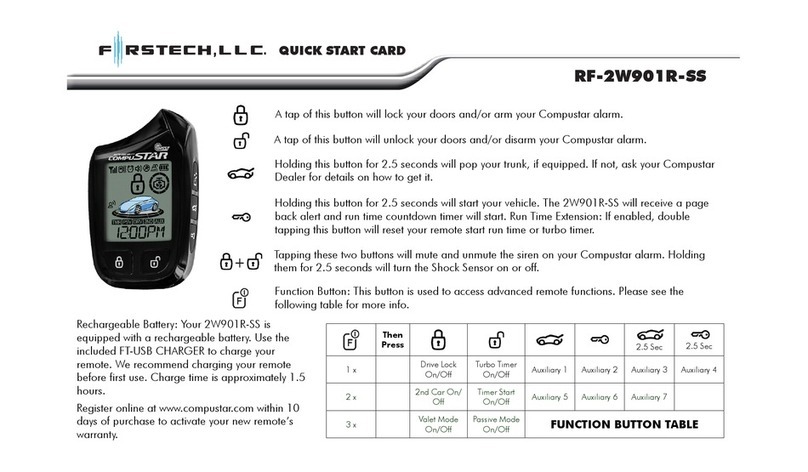
Firstech
Firstech RF-2W901R-SS Technical manual
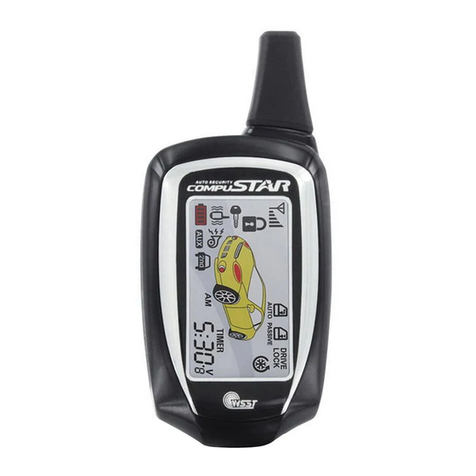
Firstech
Firstech Compustar RF-2W9000FM User manual
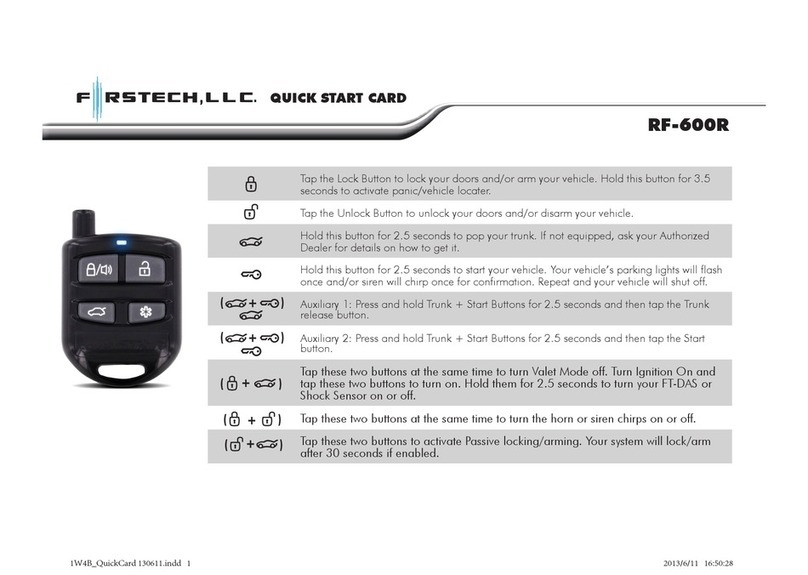
Firstech
Firstech RF-600R Technical manual

Firstech
Firstech CM7000 Use and care manual
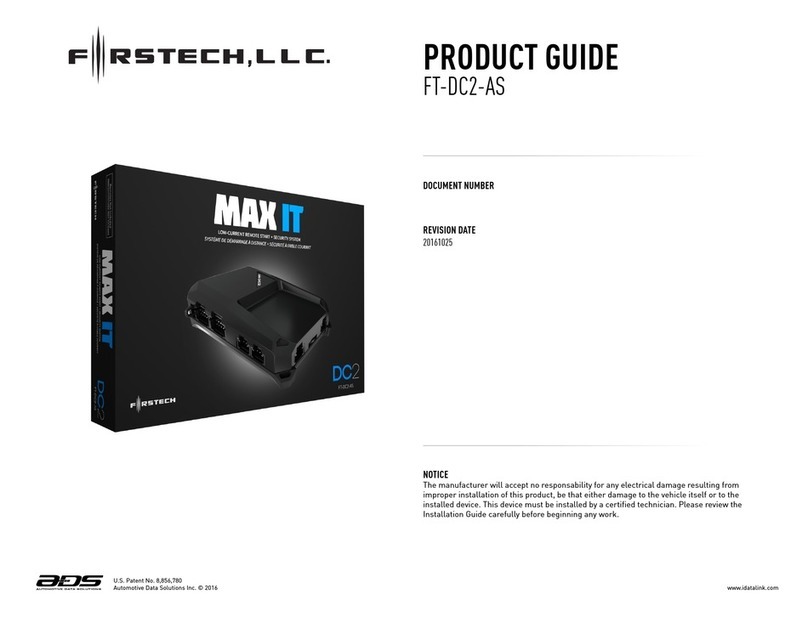
Firstech
Firstech MAX It FT-DC2-AS User manual
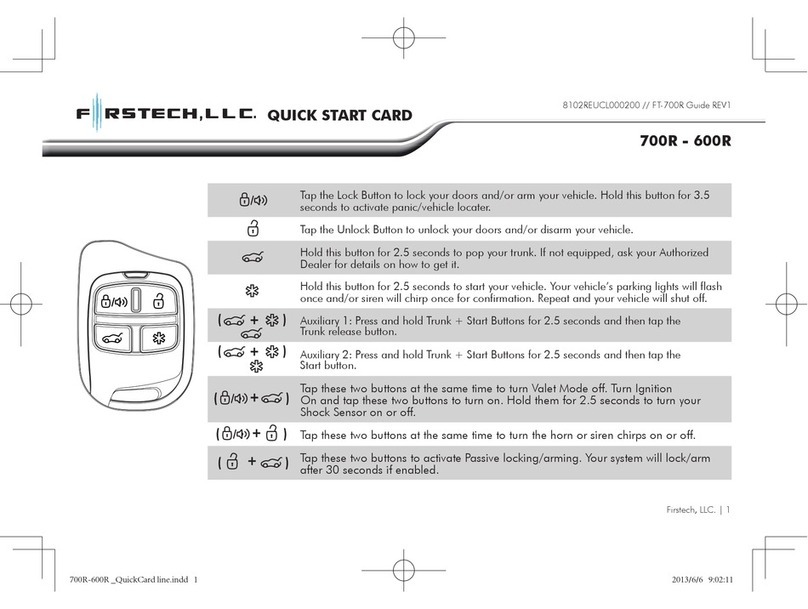
Firstech
Firstech 700R Technical manual

Firstech
Firstech CM6300 User manual

Firstech
Firstech CM-2305A User manual
